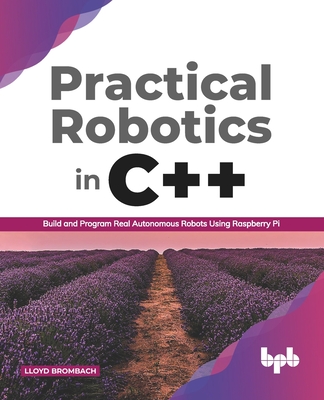Autonomous Vehicle Lidar: A Tutorial
暫譯: 自駕車激光雷達:教程
Zhou, Kai, Baab, Andrew, Calhoun, Ronald
- 出版商: Independently Published
- 出版日期: 2019-12-31
- 售價: $1,040
- 貴賓價: 9.8 折 $1,019
- 語言: 英文
- 頁數: 108
- 裝訂: Quality Paper - also called trade paper
- ISBN: 1653277912
- ISBN-13: 9781653277919
-
相關分類:
自駕車
立即出貨 (庫存 < 3)
買這商品的人也買了...
-
 世界第一簡單馬達
世界第一簡單馬達$280$238 -
 $301電子數據取證與Python方法(Python forensics: a workbench for inventing and sharing digital forensic technology)
$301電子數據取證與Python方法(Python forensics: a workbench for inventing and sharing digital forensic technology) -
 Windows 黑客編程技術詳解
Windows 黑客編程技術詳解$648$616 -
 乾脆一次搞清楚:最完整詳細網路協定全書
乾脆一次搞清楚:最完整詳細網路協定全書$690$545 -
 $1,015MATLAB 金融風險管理師 FRM (一級)
$1,015MATLAB 金融風險管理師 FRM (一級) -
 $1,015MATLAB 金融風險管理師 FRM (超綱實戰)
$1,015MATLAB 金融風險管理師 FRM (超綱實戰) -
 $1,015MATLAB 金融風險管理師 FRM (二級)
$1,015MATLAB 金融風險管理師 FRM (二級) -
 $1,015MATLAB 金融風險管理師 FRM (高階實戰)
$1,015MATLAB 金融風險管理師 FRM (高階實戰) -
 核心開發者親授!PyTorch 深度學習攻略 (Deep Learning with Pytorch)
核心開發者親授!PyTorch 深度學習攻略 (Deep Learning with Pytorch)$1,000$790 -
 $1,015MATLAB 金融風險管理師 FRM : 金融科技 Fintech 應用
$1,015MATLAB 金融風險管理師 FRM : 金融科技 Fintech 應用 -
 NLP 大神 RNN 網路:Python 原始程式碼手把手帶你寫
NLP 大神 RNN 網路:Python 原始程式碼手把手帶你寫$890$703 -
 高速數字接口與光電測試
高速數字接口與光電測試$1,068$1,015 -
 嵌入式實時操作系統 — 基於 ARM Mbed OS 的應用實踐
嵌入式實時操作系統 — 基於 ARM Mbed OS 的應用實踐$828$787 -
 PID 控制系統設計 — 使用 MATLAB 和 Simulink 模擬與分析
PID 控制系統設計 — 使用 MATLAB 和 Simulink 模擬與分析$534$507 -
 $354基於深度學習和GNU Radio的調制信號分析實戰
$354基於深度學習和GNU Radio的調制信號分析實戰 -
 Effective C (中文版)
Effective C (中文版)$539$512 -
 $1,223矩陣力量 (線性代數全彩圖解 + 微課 + Python 編程)
$1,223矩陣力量 (線性代數全彩圖解 + 微課 + Python 編程) -
 $473YOLO 目標檢測
$473YOLO 目標檢測 -
 跟 NVIDIA 學深度學習!從基本神經網路到 ......、GPT、BERT...,紮穩機器視覺與大型語言模型 (LLM) 的建模基礎
跟 NVIDIA 學深度學習!從基本神經網路到 ......、GPT、BERT...,紮穩機器視覺與大型語言模型 (LLM) 的建模基礎$880$748 -
 零基礎學 FPGA 設計-理解硬體程式編輯概念
零基礎學 FPGA 設計-理解硬體程式編輯概念$550$523 -
 Python 金融數據分析
Python 金融數據分析$1,074$1,020 -
 Linux 核心除錯實務 (Linux Kernel Debugging: Leverage proven tools and advanced techniques to effectively debug Linux kernels and kernel modules)
Linux 核心除錯實務 (Linux Kernel Debugging: Leverage proven tools and advanced techniques to effectively debug Linux kernels and kernel modules)$800$632 -
 線性代數與數據學習
線性代數與數據學習$828$787 -
 Microcontroller Exploits (Hardcover)
Microcontroller Exploits (Hardcover)$1,748$1,656 -
 $1,128數據有道 (數據分析 + 圖論與網絡 + 微課 + Python 編程)
$1,128數據有道 (數據分析 + 圖論與網絡 + 微課 + Python 編程)
相關主題
商品描述
The largest high-tech companies and leading automobile manufacturers in the world have unleashed torrents of effort and capital to position themselves for the arrival of autonomous vehicles. What is the fuss about? What is at stake? What are the leading sensor technologies? What is meant by "flash lidar" or "time-of-flight" sensors? With no less than 40 - 50 lidar companies vying to create mainstream automotive sensors, the climate is unique for young scientists and engineers to enter the field. What are the alliances forming between the companies, and how are they shifting? Who are current incumbents in the field? This tutorial text aims to introduce a technical but nonspecialist reader to autonomous vehicle lidar, starting from the fundamental physics of lidar and motivation for its application to autonomous vehicle systems. We will then introduce time of flight design concepts, following the light pathway through the source and transmitter optics to the photodetector. Next two distinct timing methods will be introduced, followed up by a brief discussion of beam steering. After finishing this text, the reader should be prepared to enter into laboratory explorations on the topic.
商品描述(中文翻譯)
全球最大的高科技公司和領先的汽車製造商已經投入大量的努力和資本,以為自動駕駛車輛的到來做好準備。這到底是什麼熱潮?有什麼風險?目前主要的感測技術有哪些?什麼是「閃光雷達」(flash lidar)或「飛行時間」(time-of-flight)感測器?目前有不下於40到50家雷達公司競相開發主流汽車感測器,這為年輕的科學家和工程師進入這個領域創造了獨特的環境。這些公司之間正在形成什麼樣的聯盟,並且這些聯盟又是如何變化的?目前這個領域的主要參與者是誰?本教程旨在向技術但非專業的讀者介紹自動駕駛車輛的雷達技術,從雷達的基本物理學和其在自動駕駛系統中應用的動機開始。我們將介紹飛行時間設計概念,跟隨光源和發射器光學到光電探測器的光路。接下來將介紹兩種不同的計時方法,並簡要討論光束導向。在完成本文本後,讀者應該準備好進入該主題的實驗室探索。






















